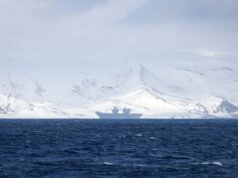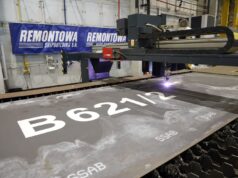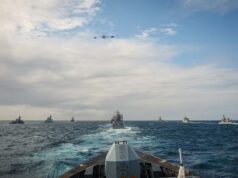Wasp, which has undergone significant upgrades to be able to land and launch the F-35B, will replace USS Bonhomme Richard in the region.
Even though the amphibious assault ship is smaller than the US aircraft carriers in the region– including the Japan-based USS Ronald Reagan — the presence of an F-35B armed Wasp creates the impression of the US having a second aircraft carrier in the region.
“The arrival of USS Wasp represents an increase in military capability and a commitment to our partners and allies for security and stability in the region,” said Capt. Colby Howard, Wasp Commanding Officer.
“Paired with the F-35B Joint Strike Fighter, we remain ready to execute the full range of military operations from crisis response to disaster relief.”
The F-35B is scheduled to embark on Wasp when the amphibious assault ship and MEU deploy in 2018 for regularly scheduled regional patrol.
“It’s an exciting time to be in the Navy, and an exciting time for Wasp and her crew, given the wide variety of missions we have the opportunity to support,” said Wasp Command Master Chief Gregory Carlson in a release.
“Over the last 18 months, this crew has not only performing their daily duties in an exemplary manner, but grown as individuals and well-represented the U.S. as ambassadors as we have served across the globe. While I’m proud of what they have accomplished, I’m also very proud of who they’ve become as a crew.”













“Wasp, which has undergone significant upgrades to be able to land and launch the F-35B”
40,000 tonnes, length 257 m. I want to know how many F35-Bs she can take!
Depends on mission. Baseline setup (QRF) setup is 6 F-35, 4 AH-1 Zulu Cobra, 12 MV-22 Osprey, 4 C-53E (soon to be 53K), 4 UH-1 Venom. Balanced deployment as possible.
Rapid Assault 24 Osprey, 8 Cobra, 4 C53E. Meant to move as many infantry and artillery ashore so landing craft can deploy tanks and armored vehicles as quickly as possible. Note only authorized while part of a CSG.
Sea Control/Air Dominance, 20 F35 by the book however more have been tested, 6 ASW helicopters (model varies). 2 Osprey in tanker configuration (planned).
Note these are all the base packages. The USN and USMC mix and match from these more often than not.
So we could have had 40t CVAs carrying 24 F35s. Alongside would be a 40t Tide which could have been designed to carry 8 Wildcats and have a double pad. Escorting them could be 4 large escorts with 8 more. That would be a properly good air/sea control force. Substituting 8 F35s for Chinooks would still be good and provide LPH capacity.
In fact the RFA have several large ships (Forts, Waves, Victoria, Points, Bays) which could all be the same so we could have had 16 ships with fuel tanks or stores or vehicles and 4 more slightly stretched and with a flat top. Build them every 18 months and that is a permanant production line.
Tim, still could. I think the UK was right to go for the QEs, and for a few years will be doint the T26 as escorts, and the T31e for GP or even as part of a XSG, finishing the Astute build, then build up along the lines you’res suggesting.
I hope that’s the plan anyway.
Jings, “doing” and “CSG”. Cold fingers!
Thanks Elliott, that’s great. Very impressive. I’m presuming also that the F35-B could land on the Nimitzes, and it seems to me that over the years the F35-B could outsell the other variants, which would happily reduce unit costs.
The Wasp class are arguably what the UK should have built if the plan all along was to use a small fleet of F35’s. It also has some V22’s and a helicopter package.
They are deployed with a squadron of 16 F35B’s have a crew of 1075 and can take 2200 marines and their equipment.
All pretty sensational really – pity it costs a fortune..
A UKDJ article about the QEC carriers’ size.
https://ukdefencejournal.org.uk/why-are-the-queen-elizabeth-class-carriers-so-big/
I agree totally. Its what the Navy really required x2. Less of these behemoth floating targets Admiral’s vanity projects.
The key seems to be that the large deck of the QEC’s is that aircraft can be refuelled and rearmed much more quickly than on a smaller deck. So even the same number of aircraft can achieve a higher sortie rate from a big deck. I am sure this was part of the calculations for the design and size of our new carriers from the start.
Yes, and I have a feeling they could work WITH RFAs or LDAs, to use the extra carrying capacity of a longer takeoff and the ramp for full load. Quick ferry across to the QEs, refuel full and arm full load and off into the wild blue yonder.
Gents
I am not suggesting that the QEC’s are not good – they are amazing. But for what the UK is able to put out there 4 Wasp class Amphibious vessels (with all the great tech in the QEC incorporated) would probably serve us better given we will not even have enough aircraft to fill one QEC (70 F35’bs per carrier).
These are twice the size of the invincible class, have enough room for 2200 marines (blimey) and their kit and can have 16 F35b’s (when we are looking at sailing around with 12 on our massive super carrier).
Sorry but horses for courses – we should stop trying to be a min US military and decide what is best for us – I think 4 Wasp class vessels would be better than 2 QEC’s and the loss of significant elements of our other naval forces. It would still have been a massive uplift for us and we would still be interoperable with the USMC – it might even have meant we could buy more aircraft including the V22’s.
We have them and I am very proud of them – but still stand by the fact the Wasp class (or America class) are very capable assets and ones we could have done with.
pacman27 – Ref your comment about we should have had 4 x Wasp type ships. The USA has now switched to the ‘America Class’ and the first ships will not have Welldecks as the last of the ‘Wasp Class’ didn’t. But even without that @ $3.5 Bn a piece that would be a cost of $14 Bn or £10 Bn for what would be larger HMS Ocean ships. We built two much larger assets for £7 Bn.
I still hold the view that we do not have the financial muscle to go down the US route of duplicated assets for each arm of their forces. Lucky them. So it is right to develop the carriers which will provide flexible air support platforms but we should specialise more in larger ‘Albion Class’ ships and develop the ‘Bay Class’ into a larger fleet. Each of those has a greater flexibility of use which gives better value for our fewer £.
How would you crew 4 Wasp class? We are struggling to find 1500 bodies for the 2 carriers and each Wasp class needs over 1200 crew. Also there would have been no cost savings over the CVF programme so no money for V-22. The Queen Elizabeth class are superior to the Wasps in every regard and are exactly what we need. They can carry as many F-35B as we will have available plus a host of helicopters, up to 50 aircraft in surge conditions as you yourself have pointed out previously. The Wasp can’t do that. What then is the benefit of the Wasp class? So that the deck looks less empty? Also we don’t have enough landing craft to fill 4 Wasp class. What we need is to keep our LPDs as the combination of those 2 and the 2 carriers is exponentially better and more suited to our requirements than the Wasp.
I also think that now we have them – we need to have 144 frontline F35’s so we can run both carriers with a standing force of 32 F35’bs on them and surge to 64 per carrier if need be.
But understand this won’t happen.. and there in itself is my point – these things should always be 60%+ full to ensure they have the right operational tempo (otherwise its the equivalent of sending a Div 2 footballer to the premiership at an hours notice) – It might work, but it more than likely won’t when you need to scale up.
Can I just remind the QE knocking crew that the USS Wasp is nearly 30 years old (and cost some $3 Bn in today’s money) and while the US is excellent at keeping things going for years we should remember its limitations and purpose:
No ramp = Lower take off weight and reduced firepower
No SRVL – Lower landing weights and wasted munitions
Hover landings = Reduced flight deck operational flexibility
Small deckspace = slower initial sortie and retrieval rates
It is an excellent LHD designed specifically for amphibious landing support. However we do not need a flat top Albion just two more (larger) versions of them
It is also worth remembering that the USA has the luxury of a huge military budget that allows four independent forces that stick to their own priorities. That also allows 3 distinct users of fixed wing air power; USAF, USMC and USN. The Wasp Class is a USMC specific ship and would find no use in the USN.
In the UK due to far smaller budgets (and different fiscal and social priorities) our three forces are obliged to work far more closely together. And yes they do tread on each others toes far too much. But that means our carriers are far more than just ‘carriers of F-35s’. They will have varied roles and have a flexible air wing attached as necessary. By any stretch the QEs will be far more capable at delivering F-35Bs than a USS wasp will ever be but will need Albions alongside in an amphibious landing
“No ramp = Lower take off weight and reduced firepower
No SRVL – Lower landing weights and wasted munitions”
I agree with the first, but because of the first, not the second!
dadsarmy – I was discussing the limitations of operating F-35s off the USS Wasp. If you have to make a slow approach to Port and then make a sideways hover and land the weight that can be returned to the ship is greatly reduced compared to SRVL. It was the problem with Harriers – Greater take off weight off the ramp but fuel and weapons had to be dumped (wasted) if they were not used on a mission to allow a hover landing. And to operate SRVL safely you need a larger flight deck than Wasp has to offer
I get you. It’d be interesting to see the numbers, but I daresay they’re a little confidential 🙂
Like thr thinking on the Albions but we are not going to get 2 additional and larger ones. Might get 2 Karel Doorman style JSS as part of the FSS project though.
Chris – I am not knocking the QEC – I love them, but I do think its a valid point that if we can’t fill them why build them to sail around 2/3 empty.
We are bemoaning the fact we are losing Ocean and potentially other assets and this class seem to fit into our budget, strategy and capability (if as I have stated we did the same tech/design job on our version as we have with the QEC’s)
I also make reference to the huge cost of these and the fact they have been replaced by America class. I for one am not knocking the QEC but I am having a go at the politicians and the MOD top brass who have signed us up for 2 massive ships that we dont seem able to run at anywhere near capacity.
HMS Prince of Wales, following modifications, might be seen as similar in role to USS America rather than Wasp.
But there is no point in making comparisons with the US, their defence spending is vast compared to any other nation by some magnitude.
The main difference between the Wasp and the QE is that her Marines don’t have to sleep on camp beds in the hanger!
Albion – And given the RMs attitude I suspect not one f**k will be given …. And I couldn’t possibly comment on the air conditioning and heating needs of the USMC
Sleeping on a camp bed! Oh the horror of war…
The principal of the wasp class is to provide air, logistics, transportation and medical support to to a Expeditionary Strike Group (ESG). This is because the USN came to the conclusion that amphibious warfare ships such as the San Antonio class or Albion class can not keep up with a Carrier Strike Group (CSG) when they are doing a emergency redeployment. The Burkes, Ticos, Nimitz and Ford classes were designed to be able to make a high speed crossing of the Pacific if needed at 30 knots, then refuel in theater at say Yokosuka NB for instance. This however meant leaving amphibious assets unprotected so the decision was made to build Wasp and now America classes the ability to operate autonomously if necessary. This also allows the USMC to maintain with fewer hulls their stated goal of being able to deliver a force of 2-3 companies anywhere reachable by sea within 24hrs and a regiment with armor to any coast within 48-56hrs.
The QE’s are amazing ships, but are fundamentally crippled by the lack of enough f35s. No point having such big ships without adequate jets and relying on the US is not a sensible solution, as we are not here to top up the US defence budget up.
Something like the wasps would have made a lot more sense. Replaced the Albion without much in the way of extra sailors and yet big capability jump over them.
Tosh
Better to have 2 QEs with an initial capability of 24 F35s increasing year by year, with full load and fuel take-off and landing capabilty, than 2 half-size carriers with nowhere to put even 60 F35s, let alone 100 or more later on, and restricted in mission load weight.
Can’t agree with your logic here; we can only afford x F-35s so we should have built smaller flat tops? As I understand it the order for 138 F-35s is still the intention. Even a moderate cost reduction of number should still enable the UK to deploy a credible 1st day strike carrier capability, though we need not to get seduced by the F-35A mixed fleet argument. And our expeditionary capability is substantial and balanced if we retain the LPDs and the RM of course.